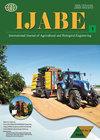基于日农业气象指数的湖北省棉花生育期水旱分析
IF 2.2
2区 农林科学
Q2 AGRICULTURAL ENGINEERING
International Journal of Agricultural and Biological Engineering
Pub Date : 2023-01-01
DOI:10.25165/j.ijabe.20231604.6795
引用次数: 0
摘要
全球棉花产量受到发生在不同生长阶段的洪水和干旱的限制。本研究采用标准化降水蒸散指数(SAPEI)对1961 - 2019年中国棉花大省湖北棉花汛期和干旱进行了生长阶段分析。此外,利用多元回归模型定量分析了水旱对棉花气候产量的影响。结果表明:棉花涝旱强度的时间变化趋势总体平稳,但在开花期和成铃期,棉花干旱强度有明显的下降趋势;此外,棉花干旱强度的变化比洪涝强度的变化更剧烈。棉花各生育期的水淹倾向均远大于干旱倾向,其中最易发生水淹的时期为开花成铃期,最易发生干旱的时期为出芽期。从空间分布上看,鄂东北和鄂西南最容易发生洪涝灾害,最容易发生干旱灾害。基于sapei的回归模型(R2=0.490, p<0.001)明显优于基于spei的回归模型(R2=0.278, p<0.05),结果表明棉花洪涝和干旱对棉花气候产量的影响均为负显著,且棉花洪涝的减产效应远远大于干旱。此外,当采用回归分析进一步考虑生育阶段时,发现只有开花和成铃阶段对棉花的减产影响显著。综上所述,SAPEI可有效辅助棉花水旱监测;棉花水淹是湖北省棉田水分管理的关键问题,特别是花铃期和鄂东北地区的棉花水淹。[关键词]灌溉排水气候产量内涝[DOI: 10.25165/ j.j ijabe.20231604.6795]引用本文:钱磊,陈超,陈晓华,曾文忠,高永文,邓克宁。基于日农业气象指数的湖北省棉花生育期水旱分析。农业与生物工程学报,2023;16(4): 174 - 184。本文章由计算机程序翻译,如有差异,请以英文原文为准。
Cotton flooding and drought analysis regarding growth stages in Hubei, China, using a daily agrometeorological index
Cotton yield is restricted worldwide by flooding and drought that occur across various growth stages. In this study, cotton flooding and drought in Hubei (a major cotton-production province in China) from 1961 to 2019 were analyzed regarding growth stages through a daily index named the standardized antecedent precipitation evapotranspiration index (SAPEI). In addition, the impacts of flooding and drought on cotton climatic yield were quantified using multiple regression models. The results showed that the temporal trends of cotton flooding and drought intensities were generally smooth, except for an obvious downward trend for cotton drought intensity at the flowering and boll-forming stage. Additionally, cotton drought intensity varied more drastically than that of flooding over the years. Cotton-flooding proneness was much greater than cotton-drought proneness at all growth stages, and the most flooding-prone and drought-prone periods were identified as the flowering and boll-forming stage and the budding stage, respectively. In terms of spatial distribution, northeastern Hubei and southwestern Hubei were most prone to flooding and drought, respectively. The SAPEI-based regression model (R2=0.490, p<0.001), obviously outperforming the SPEI-based model (R2=0.278, p<0.05), revealed that both cotton flooding and drought exhibited negatively significant effects on cotton climatic yield and that the yield-reducing effect of cotton flooding was much greater than that of drought. Moreover, when growth stages were further considered using regression analysis, only the flowering and boll-forming stage was detected with a significant yield-reducing effect of cotton flooding. In conclusion, the SAPEI can effectively assist in monitoring cotton flooding and drought; cotton flooding, especially during the flowering and boll-forming stage and that occurring in northeastern Hubei, is the key issue for cotton field water management in Hubei. Keywords: irrigation, drainage, climatic yield, waterlogging DOI: 10.25165/j.ijabe.20231604.6795 Citation: Qian L, Chen C, Chen X H, Zeng W Z, Gao Y W, Deng K N. Cotton flooding and drought analysis regarding growth stages in Hubei, China, using a daily agrometeorological index. Int J Agric & Biol Eng, 2023; 16(4): 174–184.
求助全文
通过发布文献求助,成功后即可免费获取论文全文。
去求助
来源期刊

International Journal of Agricultural and Biological Engineering
AGRICULTURAL ENGINEERING-
CiteScore
4.30
自引率
12.50%
发文量
88
审稿时长
24 weeks
期刊介绍:
International Journal of Agricultural and Biological Engineering (IJABE, https://www.ijabe.org) is a peer reviewed open access international journal. IJABE, started in 2008, is a joint publication co-sponsored by US-based Association of Agricultural, Biological and Food Engineers (AOCABFE) and China-based Chinese Society of Agricultural Engineering (CSAE). The ISSN 1934-6344 and eISSN 1934-6352 numbers for both print and online IJABE have been registered in US. Now, Int. J. Agric. & Biol. Eng (IJABE) is published in both online and print version by Chinese Academy of Agricultural Engineering.
 求助内容:
求助内容: 应助结果提醒方式:
应助结果提醒方式:


